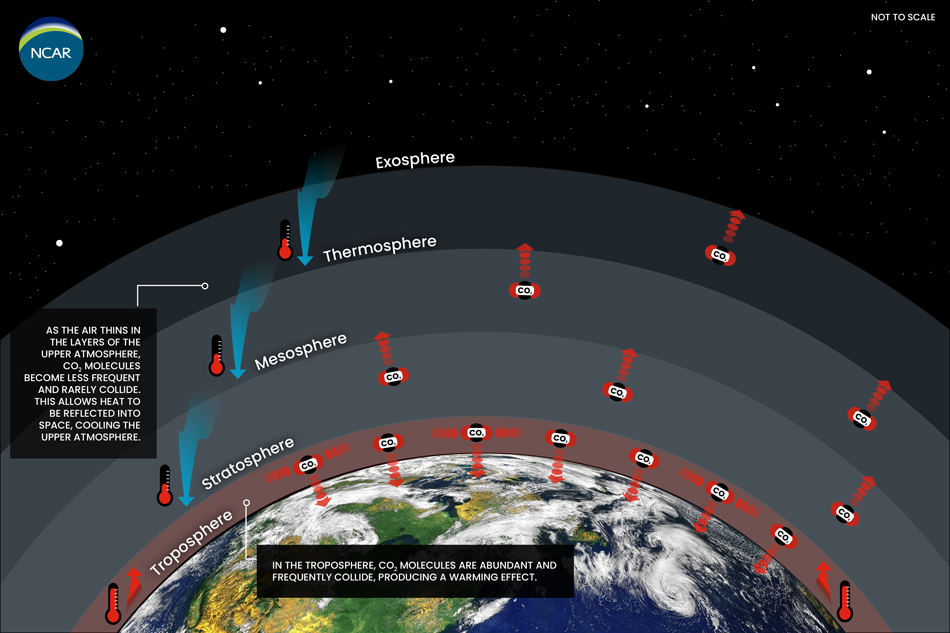The entire atmosphere in a single model
New software portrays the influence of CO2 from Earth's surface to the edge of space
May 1, 2018 - by David Hosansky
May 1, 2018 - by David Hosansky

Carbon dioxide molecules have a warming influence in the denser, lower atmosphere. Higher up, in the stratrosphere and beyond, the molecules cool the atmosphere by allowing heat to be radiated into space. (©UCAR. Image: Simmi Sinha. This image is freely available for media & nonprofit use.)
May 1, 2018 | As the atmosphere approaches the edge of space, it behaves very differently than it does closer to the surface, where weather takes place. For one thing, while the lower atmosphere warms in response to emissions of carbon dioxide (CO2), the outer and less dense atmosphere cools, radiating heat out into space.
Scientists have understood this for years, drawing on their knowledge of the physics and chemistry of the atmosphere and analysis of far-flung observations by satellites and other instruments. Now, in a major advance for computer modeling of the Earth system, they have captured these complex temperature changes in a simulation of the entire atmosphere.
"We now have a comprehensive picture that is largely in accord with the observations," said NCAR scientist Stan Solomon, the lead author of the new study. "By successfully modeling the whole atmosphere, we have demonstrated that advanced numerical simulations can describe the complexity of the layers of the atmosphere and how they influence one another."
Solomon and a team of NCAR scientists recently published their results in Geophysical Research Letters. The research was funded by the National Science Foundation, which is NCAR's sponsor, and by NASA.
CO2 molecules act as a greenhouse gas in the lower atmosphere, intercepting infrared radiation from the Earth's surface and, through collisions with other molecules, heating the atmosphere. Higher in the stratosphere and beyond however, molecules are more widely distributed, so collisions are far less frequent. In this thinner air, carbon dioxide molecules radiate the heat out to space, cooling the surrounding region.
To produce a simulation of the entire atmosphere's response to CO2, the research team turned to an advanced NCAR-based computer model: the extended version of the Whole Atmosphere Community Climate Model, or WACCM-X. The model represents the atmosphere from the planet's surface to the top of the thermosphere, more than 300 miles up, calculating temperature, density, wind, electric fields, and other variables, in three dimensions.
By representing the entire atmosphere in a single model, WACCM-X enables scientists to better understand how the different regions of the atmosphere interact with each other. They are conducting ongoing research, for example, into the ways hurricanes and other major storms near the surface send energy upward, potentially affecting the electric fields of the outer atmosphere that are important for communications and navigation systems.
"The trend in weather and climate modeling is to extend the models to higher and higher altitudes, so you're not neglecting processes that might have some effect on the big picture," Solomon said.
To put WACCM-X through its paces, Solomon and his colleagues simulated the influence of CO2 on the whole atmosphere, focusing on the period from 1974 to 2003. The simulations were run on at the NCAR-Wyoming Supercomputing Center in Cheyenne.
The results showed that, over a 30-year period under low solar activity conditions, the lowest level in the atmosphere (the troposphere) warms by about 1-2 degrees Fahrenheit. But cooling take place throughout much of the higher atmosphere, with temperatures dropping by as much as 15 degrees F in the thermosphere.
In addition to demonstrating the success of WACCM-X in simulating complex interactions across various levels of the atmosphere, this type of simulation can be important for monitoring space debris. Discarded satellite parts and rocket boosters that orbit high above Earth pose a hazard to active satellites. Their orbital paths are affected by atmospheric drag, and lower densities lead to longer orbital lifetimes and more space debris, especially when the Sun is less active.
"Understanding the density is important to satellite tracking," Solomon said. "There's a concern that a quiet Sun and reduced density in the upper atmosphere can work together, creating an environment that becomes particularly difficult for orbital navigation."